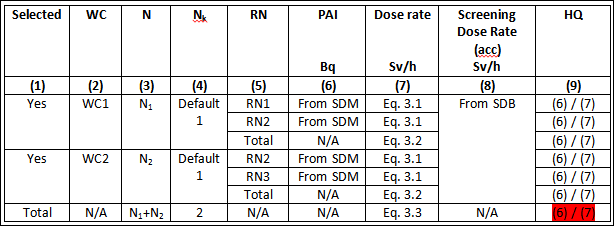Direct external exposure
For quantification of impacts of the type direct external exposure SAFRAN uses the following procedure (see Table 3.3):
For each waste component selected SAFRAN calculates the dose rate (Sv/h) resulting from exposure during at a distance of one meter from the waste components (column 7) assuming a point source geometry . This is done by multiplying the PAI value for one waste component (column 6) by the Specific Gamma Ray Dose Constant (SGRDC) and the number of waste components. The SGRDC (Sv/h per Bq) is a value for correlating the dose-equivalent rate (per unit of activity) for a radionuclide at a specified distance of 1 m. Values of the SGRDC are included in the SAFRAN Internal database. Column 4 shows the number of affected waste components (Nk), which as default is set to one for this type of impact. The user can change this value for any WC, but it should be taken into account that for processing areas this value should be one, as the PAI is the inventory involved in the process. SAFRAN calculates the dose rate for each waste component with the following equation 3.1:

The total dose (column 7) for each waste component is obtained by summing the dose from all radionuclides in the waste component:
 )
)
The total dose rate (column 7) from all affected waste components is obtained by summing the dose rates from the affected waste components (selected in column 1):

The Hazard Quotients (HQ) shown in column 9 are calculated by dividing the dose rate (column 7) by the a Screening Dose Rate for accidents (column 8). The Screening Dose Rate for accidents (Sv/h) is obtained from the SAFRAN Internal Database.This value has been obtained by dividing the Screening Dose for accidents (0.1 mSv) by an exposure time of 1 hour. Since the Screening Dose is given a conservative value and the dose rates are also conservatively calculated, then the derived HQ are also conservative. This means that if calculated HQ are below one, then it can be concluded that there is no need for performing more realistic exposure assessments. The user can also use the obtained HQ for deciding which exposure assessments should be prioritized. The user can enter his own values of the Screening Dose Rate, by adding these to the SAFRAN Internal Database or by entering the value directly in Table 3.3.
Table 3.3. Quantification of impacts of the type “direct external exposure”.

WC – waste component, N- number of waste components, RN – radionuclide, PAI – Potentially Affected Inventory, HQ – Hazard Quotient, SDM – System Description Module, SDB – SAFRAN Internal Database, N/A – not applicable. The cell marked in read is used in the Analysis Module for comparison of hazards.
Definition of columns in Table 3.3:
- Column 1. For selecting included WCs.
- Column 2. Short name of the Waste Components (WC).
- Column 3. Number of units for each WC.
- Column 4. Number of affected units for each WC.
- Column 5. Short name of the radionuclides (RN).
- Column 6. PAI for each WC.
- Column 7. External dose rate from each WC.
- Column 8. Screening external dose rate for accidents.
- Column 9. Hazards Quotient.
Columns in Table 3.3 that can be modified by the user: The user can modify the following columns: column 1 – to select waste components, column 4 – to define number of waste components affected, column, 7 – for entering directly dose rate values, 8 – for entering own values of the Screening Dose Rate (acc).